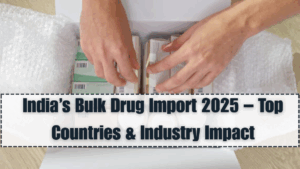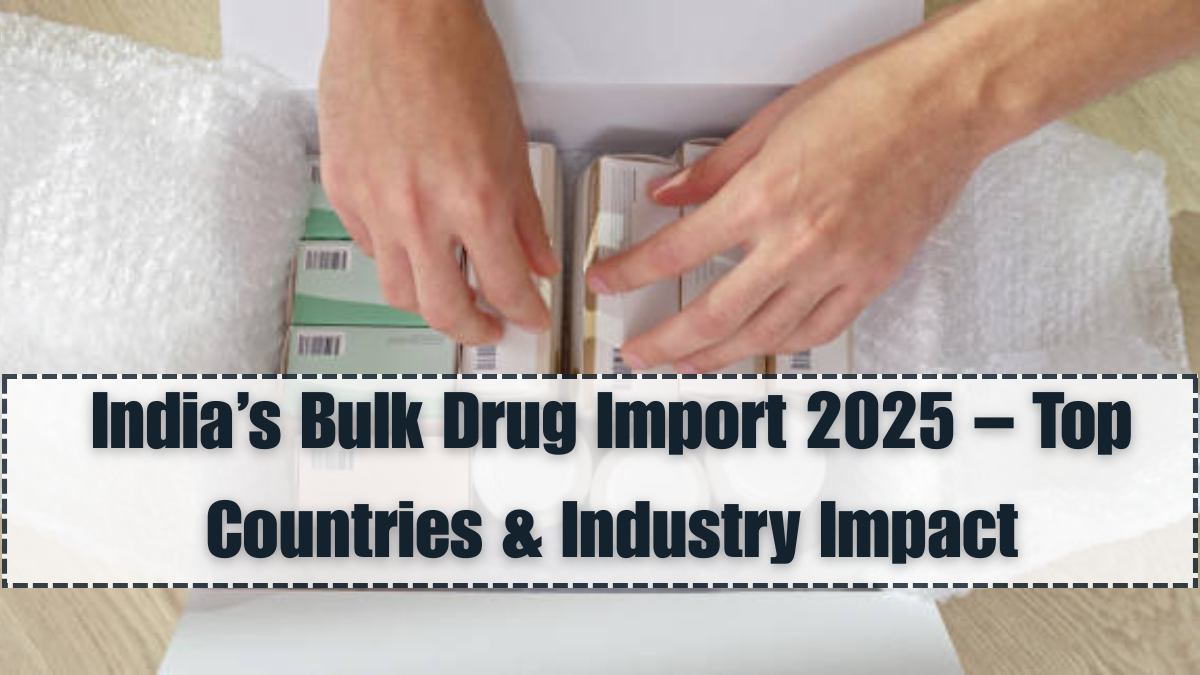The Indian Pharma Bulk Drug Import 2025 landscape reveals some critical trends in sourcing, cost dynamics, and dependency on global suppliers. Despite India being a global leader in generic drug manufacturing, a significant portion of Active Pharmaceutical Ingredients (APIs) and bulk drugs are still imported—especially from countries like China.
In 2025, bulk drug imports have crossed $4.2 billion, as per official data released by the Ministry of Chemicals and Fertilizers. The government continues to push for domestic manufacturing under the Production Linked Incentive (PLI) Scheme, yet India’s pharmaceutical ecosystem remains reliant on imports for complex and high-volume raw materials.
The Indian Pharma Bulk Drug Import 2025 data gives industry players a real-time view of sourcing strategies, cost control, and areas where India needs greater self-reliance.

Top Countries Supplying Bulk Drugs to India
The following countries remain top suppliers for India’s bulk drug requirements in 2025:
| Country | Share of Import Volume | Key APIs Supplied |
|---|---|---|
| China | 69% | Antibiotics, Vitamins, Anti-diabetics |
| USA | 8% | Specialty APIs, Biotech-based ingredients |
| Italy | 6% | Anti-inflammatory drugs, CNS APIs |
| Germany | 5% | Cardiovascular drug APIs |
| Singapore | 4% | Hormonal compounds, peptide drugs |
| Others (Japan, Spain, Korea) | 8% | Miscellaneous APIs |
The Indian Pharma Bulk Drug Import 2025 data highlights a continued dependence on China, despite active efforts to diversify. Supply chain disruptions in 2023 and 2024 had already triggered alarm bells, leading to this year’s emphasis on localization.
Current Government Strategy to Reduce Import Dependency
In response to the overwhelming import numbers, India has implemented several initiatives:
-
Bulk Drug Parks set up in Gujarat, Andhra Pradesh, and Himachal Pradesh
-
Incentives under the PLI Scheme for domestic API production
-
Reduced import duty on critical intermediates
-
Encouragement of fermentation-based and synthetic chemistry hubs
-
Financial support for R&D in backward integration
The Indian Pharma Bulk Drug Import 2025 policy now also encourages public-private partnerships to make API production cost-effective at scale.
Impact on the Indian Pharmaceutical Industry
The reliance on imports affects the pharmaceutical ecosystem in several ways:
-
Cost fluctuations due to global pricing volatility
-
Delayed drug production during supply chain disruptions
-
Regulatory scrutiny over source quality from high-risk regions
-
Limited domestic control over raw material pricing
-
Innovation gaps in backward integration technologies
Despite these challenges, Indian firms are beginning to invest in in-house API facilities. This shift is already visible in segments like paracetamol, ibuprofen, and azithromycin where local manufacturing has increased by over 20% in 2025.
Future Scope for Domestic API Manufacturers
The Indian Pharma Bulk Drug Import 2025 report also signals massive opportunity for domestic companies:
-
Export potential to neighboring countries with fewer API facilities
-
Public sector collaborations for essential drug components
-
Scope in green and sustainable synthesis technologies
-
Increased demand for phytochemicals and biosynthetic APIs
-
Opportunity to develop APIs for patented drugs going off-patent soon
The government has earmarked over ₹5,000 crore for API ecosystem development between 2025 and 2028, making it a pivotal time for Indian manufacturers.
FAQs
Which country is the largest exporter of bulk drugs to India in 2025?
China continues to be the top exporter, accounting for nearly 69% of India’s bulk drug imports.
Why does India import so many APIs despite being a pharma leader?
While India leads in finished formulations, it depends on other countries—especially China—for cost-efficient and large-scale API production.
What steps has India taken to reduce API imports?
India has launched PLI schemes, established Bulk Drug Parks, and reduced import duties to encourage local API production.
Is there any progress in reducing China dependency?
Yes, domestic API output has increased in categories like painkillers and antibiotics, but a significant reduction will take time.
Can Indian companies start exporting APIs soon?
Yes, with enhanced local production capacity, Indian firms are already exploring API exports to Southeast Asia and Africa.
Click here to know more.
